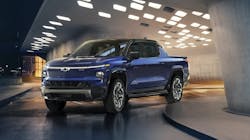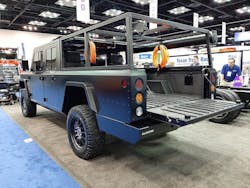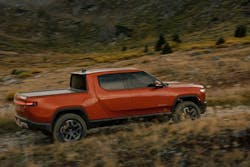Electric Pickups are At Hand
F-150 Lightning Pro
Ford’s battery-electric F-150 Lightning Pro (top) leads the domestic Big Three to market. The zero-emissions Lightning went into production early this year at Ford’s Rouge assembly plant in Detroit, and customers on the order list are just now beginning to take delivery from dealers. The Lightning shares the conventional F-150’s aluminum cab and bed but rides on its own chassis. At the NTEA Work Truck Show in March, Ford showed off several Lightnings, including stripped chassis with electric motors and battery packs in full view; the vehicles received constant attention from showgoers.
Ford touts the truck’s ability to travel and work quietly as well as power a customer’s house if grid power goes out. As with all electric vehicles, the Lightning’s filling station will be in home garages or at fleet yards, which will be outfitted with 48- or 80-amp chargers. Help in buying and installing chargers is available from Ford and other sources, so plugging in will be easy and quick. Lightning Pro will be backed by 644 electric vehicle-certified Ford Commercial Vehicle Centers across the U.S. These offer sales, service, financing and charging assistance. And there are 2,300 EV-certified Ford dealers for midsize electric trucks.
The usual engine compartment is given over to a front trunk, which the builder calls a Mega Power Frunk, offering 14.1 cubic feet of lockable, water-tight storage and the capacity to carry up to 400 pounds. It comes standard with four 120-volt AC outlets and two USB ports, with two more outlets in the cab and two in the 5.5-foot rear cargo bed. The outlets support operation of electric power tools at work sites, and the bed is ready for easy upfitting with its familiar F-150 dimensions and mounting points, Ford says.
The standard Ford F-150 Lightning Pro has an EPA-estimated 230-mile range and includes a complimentary 32-amp Ford Mobile Charger. Its lithium-ion battery and twin motors can generate up to 426 horsepower and 775 lb.-ft. of torque, can carry a 2,000-pound payload, and can tow up to 7,700 pounds with the optional Max Trailer Tow package. This model has a starting price of $39,974 before tax incentives. An extended-range Lightning can run up to 300 miles and generates as much as 563 horsepower, and with a tow package can pull up to 10,000 pounds. Its starting price is $49,974 including an 80-amp Ford Charge Station Pro, which, when combined with the included onboard dual chargers, enables affordable Level 2 overnight charging using AC power—negating the need for expensive DC power installation. Both versions feature an “always-on” 4x4 driveline by virtue of an electric motor at each axle position.
Silverado electric pickup truck
Chevrolet displayed its Silverado EV electric pickup (above) at the Work Truck Show, but it sat behind ropes on a platform, out of attendees’ reach. Chevy says its electric pickup will enter production in spring of 2023 as a 2024 model. It was developed from the ground up, using General Motors’ Ultium EV platform. The full-size Silverado EV will come in two trim levels: retail, called RST, which is already sold out; and WT, for work truck, aimed at fleet buyers. Each will have an estimated range of 400 miles on a full charge, and fast-charging capabilities add approximately 100 miles of range in just 10 minutes on public DC fast chargers, Chevrolet says. Its motors will make up to 510 horsepower and 615 ft.-lb. of torque; the truck will carry 1,200 pounds of payload and tow 8,000 pounds. Later, there will be a model with a maximum tow capacity of 20,000 pounds. The truck will have up to 10 outlets that provide a total of 10.2 kW of electric power, plus the capability to charge another EV using the available accessory charge cord. The Silverado EV will also have a front trunk.
“The frunk is an interesting value for fleet customers,” says Nichole Kraatz, chief engineer on the project. “It will help out workers with low lift-over heights. They like the idea of the frunk because it will allow them to build a toolbox at the workers’ reach. They won’t have to crawl in the bed to reach their tools. There’s also a charge port in there to charge tools.” At the other end of the EV pickup, styling and utility cues from the Chevy Avalanche are evident, with sloped abbreviated metal columns flowing off the cabin’s top and a pass-through for storage of longer items in the bed. GM will build the Silverado EV in Michigan, at its extensively refitted Detroit-Hamtramck assembly plant, now called Factory Zero, and the Lake Orion plant where Chevy Bolt EVs have been built.
Startup electric trucks delayed
Bollinger Motors, a small startup company with a big vision, has postponed its B1 pickup for a year or more, and instead shifted its engineering and production focus to electric-powered medium-duty truck chassis, according to Robert Bollinger, its founder. The company displayed several of the heavier chassis at the Work Truck Show, along with a larger pickup, the Bollinger B2. Resembling a classic Land Rover but with larger dimensions, the crew-cab B2 featured a full-length tunnel, from the bed into the front trunk, for carrying long cargo like pipes and lumber. Bollinger patented the idea, a representative said. The B2 is not in production either, but if built, it would sell for about $125,000.
Bollinger B2 electric pickup truck.
The Rivian R1T electric pickup (below) is in production at a plant in Illinois. Rivian has financial backing from Ford and Amazon, and it raised $12 billion in a public stock offering last year. It says it has built more than 2,500 vehicles and has begun deliveries to a big backlog of customers. This year it plans to produce 25,000 trucks and SUVs—about a fifth of the factory’s capacity, due to parts shortages. The truck has impressive specifications: 835 horsepower, 314 miles of range, a mile-per-gallon equivalent rating of 74 city and 66 highway, towing capacity of 11,000 pounds, and a starting price of $67,500. Rivian has also announced a huge factory complex in Georgia.
Tesla Motors has pushed its wedgy, futuristically styled Cybertruck further into the future, the result of microchip shortages and other factors, founder Elon Musk told investors earlier this year. He had hoped to move the much ballyhooed electric truck into production late last year, then late this year, and it now looks like sometime in 2023. Tesla needs to use the chips it can acquire in its automobiles rather than commit them to a new truck. Another problem is reducing cost to keep Cybertruck’s starting price anywhere near the $39,995 announced when it was shown off in 2019.
Volkswagen AG in Europe is reportedly considering the introduction of an midsize electric truck in the U.S., and it would be built somewhere in North America. VW has an automobile plant in Chattanooga, Tennessee, and in the 1970s and ’80s ran one at Westmoreland, Pennsylvania. There it made Rabbit compact sedans as well as a small Rabbit-based pickup that competed directly against the Dodge Rampage and Plymouth Scamp, clone compact pickups based on Chrysler’s K-car. All were front-wheel-drive.
Rivian R1T pickup truck.
Strong ICE sales
Electric-powered vans are closer at hand than pickups, as many e-delivery trucks are now at work or close to market. Among them are offerings from startups, but Ford’s e-Transit van is now for sale and Brightdrop, General Motors’ semi-autonomous e-van operation, might be supplying vehicles to customers in a year or so. For now, though, internal combustion engines (ICE) power a big majority of all vehicles, including retail and commercial pickups, and will be under the hoods of heavier models for quite some time. Demand is high for both gasoline and diesel engines, the latter in heavy pickups, but midsize and compact pickups are also strong in the market. So times are good, report executives with Ford, General Motors, Nissan, and Ram, the four makes engaged in the commercial market.
“F-150 and SuperDuty pickup sales are fantastic,” says Nathan Oscarson, brand manager for Ford Commercial Truck. “Demand is exceeding supply, and we’re trying to make as many as we can to meet demand. The chip supply shortage affected the entire industry.… We’re managing the shortages, though I’d have thought we’d be through it by now. We’re working through it as well as we can.” Ford has announced production interruptions since the microchip shortage began during the depths of Covid pandemic, and the stoppages continue.
“There’s been nothing but challenges for the last couple of years, from the pandemic to more recently, the chip shortages,” says Dave Sowers, head of Ram Commercial Operations. “But through all of that, pickup business has shown itself as something that’s strong in this country. In the first couple of months of the pandemic there was lockdown, but toward the end of 2020 and 2021, there was meaningful demand out there. We felt we had a pretty successful 2021. We think in those segments, including chassis-cab, we expect a strong future, barring geopolitical developments. Infrastructure investment will be good for the economy and us.”
Ed Peper, VP of GM Fleet in the U.S., says:
“Pickups are a huge deal, particularly the last couple of years. Sales [have] gone up dramatically, in construction and other jobs that need to be done. And there’s a huge amount of older trucks that must be replaced. In general, pickups remain a high percentage of the industry....There are some concerns with the gas prices starting to go up a little bit, but sales remain strong. We’re trying to get every one built in the face of very high demand. It’s a good problem to have. Chips are still a problem in general.…We’re tying to preserve our supplies by putting chips where the demand is.”
Nissan USA is working through the same parts shortages as the other truck builders, says Peter Hanley, senior manager for fleet and commercial sales. But it expects to deliver the majority of its commercial vehicles—Titan full-size and Frontier mid-size pickups as well as NV series large and small vans—in the first half of this year. The Titan performs well in sales to construction firms and among building contractors. The heavier Titan XD now comes only with gasoline power as the Cummins 5-liter diesel was dropped after model-year 2020 for lack of sales. Titans are assembled in Canton, Mississippi from components made elsewhere in the U.S.
Continuing pickup truck trends
Four-door crew cabs claim a high percentage of sales in all pickup sizes, reflecting their wide use as people movers as well as carriers of cargo. Among all GM pickups, crew cabs claim 88 percent of sales, says Ed Peper. On GM’s fleet side, it is 60 percent. Ford’s Super Crew models are still popular, reports Nate Oscarson, but fleets are still buying regular cabs, because they don’t want to overbuy.
The Big Three’s heavy pickups can be had with gasoline and diesel power, and “the mix of powertrains has overall been fairly consistent,” says Dave Sowers at Ram Trucks, in effect describing sales experience for himself and competitors. “Certain customers purchase diesels for trailer towing, others stay in gasoline. There’s recently a little movement toward gas, due to acquisition costs. The initial investment difference is between $9,000 and $11,000 more for a diesel. And gasoline engines have become more capable.”
Chevrolet, Ford, and Ram have all introduced large-displacement gasoline engines that can do hauling and towing jobs almost as well as diesels, though the oil burners still have far more torque that is important in moving heavy trailers. All trucks are now equipped with 6-, 8-, 9-, or 10-speed automatic transmissions that claim high performance and efficiency, and of course easy operation. The last manual gearbox, a 6-speed, was offered by Ram in 2018.
Fancy interiors have become more common. “More uplevel trims are sold at retail,” says Kraatz at Chevrolet. “But the mix has dramatically improved at fleet levels. They used to be bare bones, but they now a lot more equipment. Rental fleets, too: Those who buy them try to match what retail buyers want, so resale is good.” Ford has gone to six trim levels in its pickups, including a top-of-the-line Limited that seems a more cheerful version of what the company used to put in its Lincoln Town Cars. And in recent years, auto reviewers have remarked on the comfort of Ram pickups, particularly the 1500 series that has gained considerably in sales and owner loyalty.
Safety equipment “has become the No. 1 concern for fleet managers,” says Nissan’s Hanley. As with other builders, Nissan has a long list of accident-avoidance and -mitigation devices, from multiple cameras viewing a truck’s surroundings to blind-spot and rear cross-traffic warnings to automatic braking that detects pedestrians and stationary as well as moving objects in the lane ahead. Nissan claims its Automatic Rear Braking is an exclusive; with the transmission in reverse, sensors watch what the truck is backing toward and automatically apply the brakes, avoiding sometimes serious body damage. Many large fleets are self-insured, he says, “so savings from avoided collisions go right to the bottom line.”



